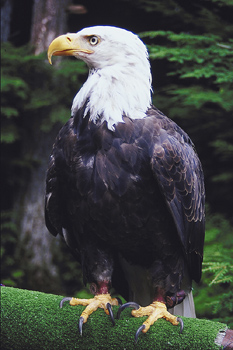Bald Eagle Facts
Bald Eagle Facts
|
| Interesting Bald Eagle Facts: |
|---|
| Bald eagles are not bald at all. Eagle looks "bald" because white feathers on the head are in contrast with dark brown feathers on the rest of the body. |
| They have around 7000 feathers. They are light, but strong. |
| Adult eagles are 3 feet tall and weigh up to 9 pounds. Females are larger than males. |
| Their wingspan ranges from 5.5 to 7.5 feet. |
| Bald eagles fly 35 miles per hour. When they "dive" through the air to catch the prey, they can reach 100 miles per hour. |
| They eat fish, other birds, muskrats and turtles. Hooked beak helps them tear apart their prey. |
| Bald eagles will steal hunt from other birds or even humans (during fishing) thanks to their speed and sharp claws. |
| Bald eagles breathe air using the holes on their beaks called "nares". |
| They have excellent eyesight and see things 4-7 times better than humans. |
| Although they don't have vocal cords, they use sounds to communicate. They produce squeaking and screeching sounds by pushing the air through the bones in their neck. |
| Bald eagles build large nests. Largest known nest was 20 feet deep, 13 feet wide and weighed nearly 3 tones. |
| Bald eagles are monogamous, which means that one pair of eagles stays together for the rest of their life. |
| Young birds are dark in color. When they turn 5 years, they will start resembling their parents. |
| Bald eagle has been national emblem of the United States ever since 1782. |
| They live 28 years in the wild and up to 36 years in captivity. |
|
Related Links: Facts Animal Facts Animals Facts |

 Bald eagles are one of the largest birds in the North America. They can be found everywhere, from Florida and California, to Newfoundland and Alaska. Their habitats are always closely associated with rivers, marshes, lakes or coasts. During 1970s, number of bald eagles decreased greatly due to habitat destruction, hunt and use of pesticides (which damage the shell of eggs). Luckily, conservation efforts (measures applied to protect the species) resulted in gradual increase in number of these beautiful birds. Today, number of bald eagles in the wild is stable and they are no longer endangered.
Bald eagles are one of the largest birds in the North America. They can be found everywhere, from Florida and California, to Newfoundland and Alaska. Their habitats are always closely associated with rivers, marshes, lakes or coasts. During 1970s, number of bald eagles decreased greatly due to habitat destruction, hunt and use of pesticides (which damage the shell of eggs). Luckily, conservation efforts (measures applied to protect the species) resulted in gradual increase in number of these beautiful birds. Today, number of bald eagles in the wild is stable and they are no longer endangered.